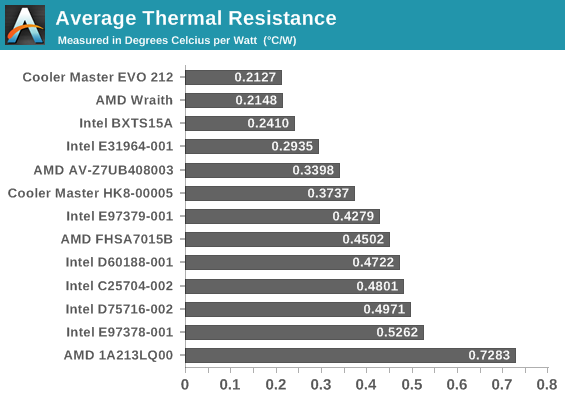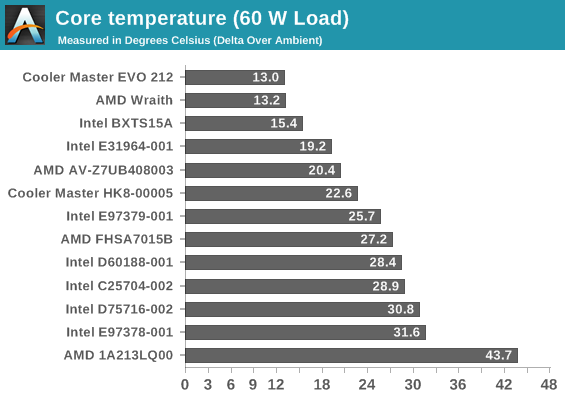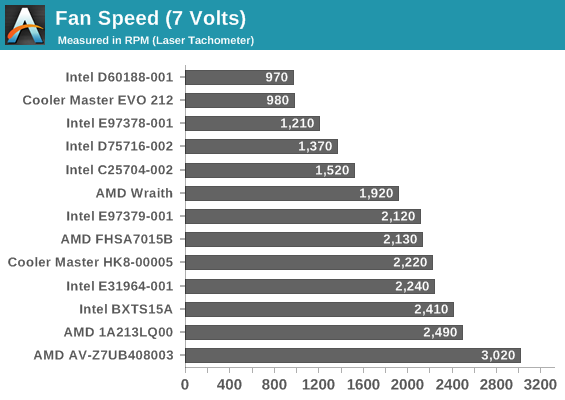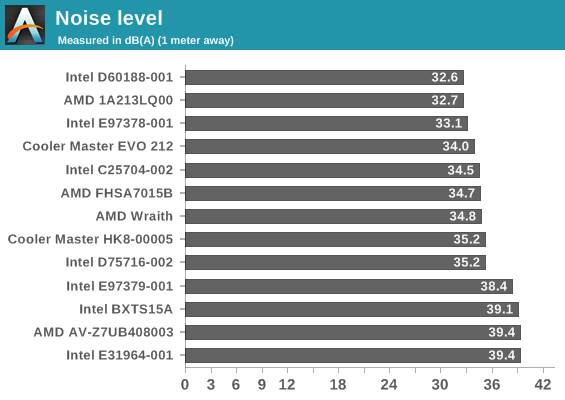Battle of The CPU Stock Coolers! 7x Intel vs 5x AMD, plus an EVO 212
by E. Fylladitakis on July 22, 2016 9:00 AM EST- Posted in
- Cases/Cooling/PSUs
- CPUs
- AMD
- Intel
- Cooler Master
- Cooler
Testing Results, Low Fan Speed (7 Volts)
Intel’s E97379-001 and AMD’s AV-Z7UB408003 coolers are equipped with automatic speed correction circuitry and adjust their speed to the maximum regardless of the input voltage. This renders the majority of basic fan controllers, rheostats and simple fan speed reduction resistors useless. Their speed can only be controlled via a PWM signal from a motherboard. The E97379-001 did have a small speed drop with an input of 6.5V and we included those results, but the AV-Z7UB408003 was rather adamant and devoid of a PWM signal would always automatically correct its speed to 3000 RPM, giving us the exact same performance results as before.

Again, the three most powerful coolers take the top spots at reduced power.

| Core Temperature, Constant Thermal Load (Low Fan Speed) |
Similarly to the 12V results, the EVO, Wraith and BXTS15A are taking the top spots. It's useful to note that EVO 212 and the Wraith are essentially equal as the power increases, with the Wraith being marginally ahead at very high thermal loads.


Putting the two "abnormal" coolers with non-adjustable fan settings aside, the thermal performance of the other coolers decreased almost equally, leaving their standings untouched. The D75716-002 still performs similarly to the C25704-002 and the D60188-001, but the former still is the loudest and the latter still is the quietest of the three. As a matter of fact, the D75716-002 is louder than the C25704-002, even though the fan is slower, hinting that either the fan has a worse engine or the denser fins significantly increased the airflow resistance of the cooler.
We cannot compare the AV-Z7UB408003 cooler to the rest of AMD’s coolers due to the autocorrecting fan. Nevertheless, we can make a useful observation looking at the Cooler Master’s HK8-00005 performance. Despite it has a slightly lower mass compared to that of the FHSA7015B and virtually the same fan, its thermal performance is much better, showcasing how two simple heatpipes can significantly increase the efficiency of a cooler.
Once again, AMD’s Wraith goes directly head to head with Cooler Master’s EVO 212, only this time the Wraith also compares in terms of acoustic comfort. There is virtually no difference between the two coolers in terms of thermal performance and both are equally silent with their fan input voltage reduced down to 7 Volts. The Intel BXTS15A does compare in terms of thermal performance but falls significantly behind when it comes to acoustics, as the cooler remains clearly audible even with its fan’s speed reduced by nearly 40%.










82 Comments
View All Comments
ZeDestructor - Monday, July 25, 2016 - link
Yes they could, but then you'd be reducing yields, which would drive final price up.pseudoid - Friday, July 22, 2016 - link
Did I miss the part about the SkyLake (LGA 1151) uPs? The Intel boxed Core I7-6700K Skylake uP comes with no cooling fan. I found that the Noctua coolers are a better fit for my needs, especially the iron-clad 3yr. warranty!LordanSS - Friday, July 22, 2016 - link
Thank you for this review.Although I already expected the 212 EVO to pull ahead (it's tough to match it on price/performance), was interesting to see the differences on the other stock ones. And the Wraith came out as a pleasant surprise.
Maybe in the US it's all about Intel and their CPUs, but in other areas of the world, like here in South America, AMD and their APUs are not doing poorly, with very good (local) pricing and decent enough performance for usual Office and light work cases, and people even use them for League of Legends and DotA2, which are very popular games around here, and not too graphics intensive.
zodiacfml - Friday, July 22, 2016 - link
I went to Intel's list of Skylake desktop CPU's and found only two that has around 90W of TDP.The 212 is only 25C above ambient at 150W.
Anything larger or more expensive than the 212 is pretty much overkill for modern CPUs.
wintermute000 - Friday, July 22, 2016 - link
"modern [Intel standard desktop] CPUs"FIFY
Ascaris - Sunday, July 24, 2016 - link
"modern [Intel standard desktop] CPUs at their stock clock and voltage settings"Byte - Saturday, July 23, 2016 - link
The hyper 212 is a bit overrated and dated, but then again i used it to test a bunch of 6700k i had fun delidding with liquid ultra and it kept them cool to 4.6/4.7GHz pretty easy.phylop - Saturday, July 23, 2016 - link
I would love to see you guys post an anthology of coolers throughout the ages. Include comparing how older coolers would perform on modern CPUs and vice versa.Teknobug - Saturday, July 23, 2016 - link
The 212 is probably the best bang per buck for HSF, can't go wrong with it. I also have a TX3 which is nearly as effective as the 212 and about $10 less, however there is one thing you must do if you're going to use it on an Intel system- ditch the flimsy black/white plastic locks and steal the ones from an Intel HSF to replace them with. Once you do that, you got a pretty solid HSF even for decently OC'd CPU's.Zap - Saturday, July 23, 2016 - link
IMO stock coolers are perfectly fine for systems that run stock speeds and aren't intended to sit running torture tests all day.Noisy? Did you enable "smart fan" in BIOS? Is that in normal use or hammering it with Prime95?
Bad temperatures? Did you install it properly? For whatever reason many people can't figure out push pins when they are super simple to use. Is your temperature "comfort level" calibrated for overclocks when you're just building a stock clocked system for family to use? Fact: Your stock clocked CPU does not require low temperatures.